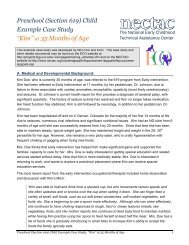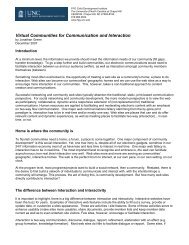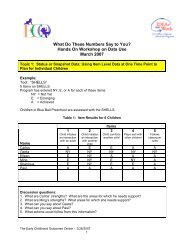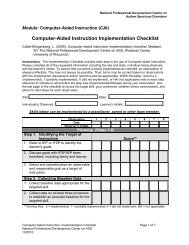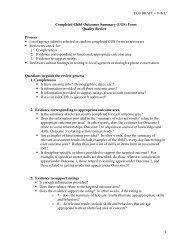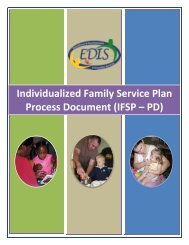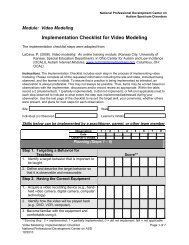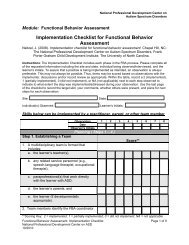Task Analysis: Steps for Implementation - National Professional ...
Task Analysis: Steps for Implementation - National Professional ...
Task Analysis: Steps for Implementation - National Professional ...
You also want an ePaper? Increase the reach of your titles
YUMPU automatically turns print PDFs into web optimized ePapers that Google loves.
<strong>National</strong> <strong>Professional</strong> Development Center onAutism Spectrum DisordersModule: <strong>Task</strong> <strong>Analysis</strong><strong>Task</strong> <strong>Analysis</strong>: <strong>Steps</strong> <strong>for</strong> <strong>Implementation</strong>Szidon, K., & Franzone, E. (2009). <strong>Task</strong> <strong>Analysis</strong>. Madison, WI: <strong>National</strong> <strong>Professional</strong>Development Center on Autism Spectrum Disorders, Waisman Center, Universityof Wisconsin.<strong>Task</strong> analysis is the process of breaking a skill down into smaller, more manageablecomponents. Once a task analysis is complete, it can be used to teach learners withASD a skill that is too challenging to teach all at once. Other practices, such as discretetrial training, video modeling, and rein<strong>for</strong>cement, can be used to teach the individualcomponents, building one upon another, until the skill is complete.Step 1. Identifying the Target Skill1. Teachers/practitioners identify the target skill that they want to teach the learnerwith ASD.Using the learner’s Individual Education Plan (IEP)/Individual Family Service Plan(IFSP) goals, teachers/practitioners should identify the skill that the learner needs toacquire. The target skill should consist of a series of chained discrete steps. A singlediscrete skill is not appropriate <strong>for</strong> task analysis, nor is a task with multiple variablesand/or outcomes.EXAMPLE #1Too simple:Just right:Toocomplex:Turning on the sink faucet (discrete skill)Washing dishesPreparing, serving, and cleaning up dinner (multiple variables andmultiple outcomes)EXAMPLE #2Too simple:Just right:Too complex:Pushing the “on” button on the computer (discrete skill)Logging onto the computer and starting a familiar programLogging onto the computer and creating a personal web page (multiplevariables and multiple outcomes)<strong>Task</strong> <strong>Analysis</strong>: <strong>Steps</strong> <strong>for</strong> <strong>Implementation</strong> Page 1 of 6<strong>National</strong> <strong>Professional</strong> Development Center on ASD10/2010
<strong>National</strong> <strong>Professional</strong> Development Center onAutism Spectrum DisordersModule: <strong>Task</strong> <strong>Analysis</strong>Of course, all instruction should be individualized. For example, a skill that may be toocomplex <strong>for</strong> one learner may be manageable <strong>for</strong> another. Skills that require a taskanalysis typically consist of multiple components that comprise a larger skill (e.g.,washing dishes, putting on a coat).<strong>Task</strong> analysis is frequently used to teach self-help and other adaptive skills.Step 2. Identifying the Prerequisite Skills of the Learner and the Materials Neededto Teach the <strong>Task</strong>1. Teachers/practitioners determine whether the learner has the requiredprerequisite skills needed to learn the task.2. Teachers/practitioners define the necessary materials needed toteach the task.Using the learner’s present level of per<strong>for</strong>mance on IEP/IFSP goals,teachers/practitioners should identify the prerequisite skills that are necessary <strong>for</strong> thelearner to have in order to per<strong>for</strong>m the target skill. Often this is done by collectingbaseline data on per<strong>for</strong>mance of the target skill. The skills that are already mastered donot need to be included as part of the task analysis.Once the prerequisite skills are identified, the instructor can decide how much detail thetask analysis will include. For example, if he or she is teaching coin counting, theteacher would first assess whether learner could identify coins and their values andwhether he or she could count by 1’s, 5’s and 10’s. These skills are the prerequisites tocoin counting. If the prerequisite skills are not mastered, they should be included as partof the task analysis. Sometimes, if there are too many prerequisite skills that need to belearned, the target skill itself might need to be redefined. In the example of coincounting, if a learner does not identify coins and their values and/or counting by 1’s, 5’s,and 10’s, these skills should be taught be<strong>for</strong>e teaching the skill of coin counting.After identifying the prerequisite skills that the learner knows and the skills that need tobe taught, the instructor should identify the materials he or she will need to teach thetask. The materials will depend on the unique needs of the learner as well as theresources available to the instructor. For coin counting, one might select a set ofsimulated coins, purchasing items, and worksheets. If the students have less ability togeneralize skills to in vivo environments, the instructor might choose to use real coins,and school and community based instruction in which to practice purchasing real items.Step 3. Breaking the Skill into Components<strong>Task</strong> <strong>Analysis</strong>: <strong>Steps</strong> <strong>for</strong> <strong>Implementation</strong> Page 2 of 6<strong>National</strong> <strong>Professional</strong> Development Center on ASD10/2010
<strong>National</strong> <strong>Professional</strong> Development Center onAutism Spectrum DisordersModule: <strong>Task</strong> <strong>Analysis</strong>In Step 3, teachers and other practitioners break the skill down into smaller steps sothat a learner can successfully demonstrate the skill by following the steps.1. Teachers/practitioners segment the target skill into more manageablecomponents by:a. completing the skill themselves and recording each step orb. observing another person (in real time or via video) complete the activity andrecording the steps.2. Teachers/practitioners confirm that each component consists of a discrete skill.TASK ANALYSIS EXAMPLE #1: Brushing Teeth (Matson et al., 1990)a. Obtains materialsb. Takes cap off toothpastec. Puts paste on brushd. Replaces toothpaste cape. Wets brushf. Brushes left outer surfacesg. Brushes front outer surfacesh. Brushes right outer surfacesi. Brushes lower right chewing surfacesj. Brushes lower left chewing surfacesk. Brushes upper left chewing surfacesl. Brushes upper right chewing surfacesm. Brushes upper right inside surfacesn. Brushes upper front inside surfaceso. Brushes upper left inside surfacesp. Brushes lower left inside surfacesq. Brushes lower front inside surfacesr. Brushes lower right inside surfacess. Rinses toothbrusht. Wipes mouth and handsu. Returns materialsEXAMPLE TASK ANALYSIS #2: Setting the Table (Goodson et al., 2006)a. Puts down the placematb. Places the large plate in the center of the placematc. Puts the small plate in the upper left hand side of the placematd. Puts the butter knife on the small platee. Places the napkin to the left of the large plate<strong>Task</strong> <strong>Analysis</strong>: <strong>Steps</strong> <strong>for</strong> <strong>Implementation</strong> Page 3 of 6<strong>National</strong> <strong>Professional</strong> Development Center on ASD10/2010
<strong>National</strong> <strong>Professional</strong> Development Center onAutism Spectrum DisordersModule: <strong>Task</strong> <strong>Analysis</strong>f. Puts the knife and spoon to the right of the large plateg. Puts the <strong>for</strong>k to the left of the large plate on the napkinh. Puts the dessert spoon and <strong>for</strong>k horizontally at the top of the large platei. Puts the glass to the upper right of the large plate near the tip of the knifeEXAMPLE TASK ANALYSIS #3: Play Activity with Trains (Liber et al., 2008)a. Asks peer to playb. Tells peer, “Let’s play trains”c. Gives peer at least two tracksd. Tells peer, “Let’s make a train”e. Asks peer <strong>for</strong> train piecesf. Puts train pieces together with peer’s piecesg. Asks peer <strong>for</strong> animals to put on trainh. Moves train around tracki. Tells peer, “Your turn!”j. Tells peer, “That was fun!”Step 4. Confirming that the <strong>Task</strong> is Completely AnalyzedIn Step 4, teachers/practitioners confirm that the component steps of the target skill arerepresented accurately and completely.1. Teachers/practitioners confirm that the task is completely analyzed by havingsomeone follow the steps verbatim.By having a colleague or another student follow the steps of the task analysis, teachers/practitioners can make certain that all steps of the skill are included and that the endresult is accurate and complete. Even if a skill is relatively simple, it is easy to leave outsteps. Having another person follow the steps exactly as written confirms whether thetask analysis is accurate. If needed, teachers/practitioners revise the component stepsbased on the feedback obtained through the trial.Step 5. Determining How the Skill Will be TaughtIn Step 5, teachers/practitioners decide how the steps identified in the task analysis willbe taught. In deciding, the teacher/practitioner needs to decide whether the task ismanageable or needs to be broken down into phases, the procedure they will use <strong>for</strong>chaining the behavior (total task, backwards, or <strong>for</strong>ward chaining), and the evidencebasedpractice they will use to teach the skill. Be<strong>for</strong>e making these decisions, it isimportant to consider learner differences, goals, and experiences. Using professionaljudgment and understanding the learner’s individual needs are important when selectingthe most appropriate evidence-based practice and implementation strategy.<strong>Task</strong> <strong>Analysis</strong>: <strong>Steps</strong> <strong>for</strong> <strong>Implementation</strong> Page 4 of 6<strong>National</strong> <strong>Professional</strong> Development Center on ASD10/2010
<strong>National</strong> <strong>Professional</strong> Development Center onAutism Spectrum DisordersModule: <strong>Task</strong> <strong>Analysis</strong>1. Teachers/practitioners select the appropriate teaching method by matching themethod to:a. the learner’s temperament,b. the learner’s learning style,c. the history of what has and has not worked <strong>for</strong> this learner,d. the learner’s IEP/IFSP, ande. the environments within which the learner functions.2. Teachers/practitioners present the steps of the task analysis to learners in anage and developmentally-appropriate manner.Teachers/practitioners must decide how the steps of the task analysis will berepresented <strong>for</strong> learners. A learner who reads may have the steps written out. Anotherlearner may require pictures to represent the steps. Yet another learner may benefitfrom a video model. Regardless of the <strong>for</strong>mat, the steps should be provided in anefficient, clearly understood manner that does not attract undue attention to learnersStep 6. Implementing Intervention and Monitoring ProgressAs noted in Step 5, a number of evidence-based practices, including prompting andrein<strong>for</strong>cement, may be appropriate <strong>for</strong> teaching specific skills. Please use resources(steps, implementation checklists, and data collection sheets) developed by the <strong>National</strong><strong>Professional</strong> Development Center on ASD in this module to assist in teaching skills andmonitoring learner progress.1. Teachers/practitioners implement the evidence-based practices identified asappropriate to teach the target skills using the steps <strong>for</strong> implementation andimplementation checklist <strong>for</strong> the selected practices.2. Teachers/practitioners follow appropriate data collection procedures to monitorlearner progress <strong>for</strong> the specific evidence-based practices chosen to teach thetarget skills.References<strong>Task</strong> <strong>Analysis</strong>: <strong>Steps</strong> <strong>for</strong> <strong>Implementation</strong> Page 5 of 6<strong>National</strong> <strong>Professional</strong> Development Center on ASD10/2010
<strong>National</strong> <strong>Professional</strong> Development Center onAutism Spectrum DisordersModule: <strong>Task</strong> <strong>Analysis</strong>Goodson, J., Sigafoos, J., O’Reilly, M, Cannella, H., & Lancioni, G.E. (2006). Evaluation of avideo-based error correction procedure <strong>for</strong> teaching a domestic skill to individuals withdevelopmental disabilities. Research in Developmental Disabilities, 28, 458-467.Liber, D., Frea, W., & Symon, J. (2008). Using time-delay to improve social play skills with peers<strong>for</strong> children with autism. Journal of Autism and Developmental Disorders, 38, 312-323.Matson, J., Taras, M., Seven, J., Love, S., & Fridley, D. (1990). Teaching self-help skills toautistic and mentally retarded children. Research in Developmental Disabilities, 11, 361-378.<strong>Task</strong> <strong>Analysis</strong>: <strong>Steps</strong> <strong>for</strong> <strong>Implementation</strong> Page 6 of 6<strong>National</strong> <strong>Professional</strong> Development Center on ASD10/2010



